Hey gang. It’s been a minute.
Or much, much longer, if you subscribe to that whole “weeks where decades pass” business. The last time we spoke, I was searching for invisible riots and picking fights with international bestselling authors. What can I say? It’s a living.
Except it’s not, actually. That’s partly the reason for my long absence, I’ve been trying to make some money to “keep the wolf away”, as my grandad used to put it. I’ve also been involved in a couple of Top Secret projects, one of which (I hope) will help us fight the next phase of the war.
And, make no mistake, that’s what’s happening. We are transitioning from one phase of battle to the next. When I suggested we throw our lot in with Trumpzilla, despite our darkest suspicions, I wasn’t under any illusions that his election would mark the end of the war. It barely marks the beginning.
In that spirit, I’ve been working on the following longform piece. Like my first essay of 2024, it will get personal at times. Parts may even sound heretical, to some of my religious readers. If any of it offends you, I’ll ask for your forgiveness in advance. But I need to write about the world as it’s been shown to me, in all its beauty and horror.
Otherwise, what’s it all been for?
Introduction
“Be not afraid.”
A strange request.
After all, fear isn’t a choice we make, any more than laughter is. It’s an involuntary response, something that happens to us. We can attempt to control it, or to steel ourselves against it. We can train ourselves to overcome various forms of it, and even use it to our advantage. But before it can be overcome, it must be felt. It’s much the same as mercy, in that sense. You cannot logically show mercy to your victorious oppressors, only to your vanquished ones.
Fear itself is a type of oppressor. To dethrone it, we must first identify its particular species. There’s a broad spectrum of physical fears, both immediate (the leap from the airplane; the psycho with the machete) and long term (the parasitic infection, the cancer diagnosis). There are also fears that are more mysterious and metaphysical, like the kind that oppresses Hamlet at Elsinore.
To sleep, perchance to dream—ay, there's the rub:
For in that sleep of death what dreams may come,
When we have shuffled off this mortal coil,
Must give us pause—there's the respect
That makes calamity of so long life.
For who would bear the whips and scorns of time,
Th'oppressor's wrong, the proud man's contumely,
The pangs of dispriz'd love, the law's delay,
The insolence of office, and the spurns
That patient merit of th'unworthy takes,
When he himself might his quietus make
With a bare bodkin? Who would fardels bear,
To grunt and sweat under a weary life,
But that the dread of something after death,
The undiscovere'd country, from whose bourn
No traveller returns, puzzles the will,
And makes us rather bear those ills we have
Than fly to others that we know not of?
Thus conscience doth make cowards of us all
This is similar to the species of terror found near the edge of the map, on the brink of uncharted territory. These fears are often tempered by the electric frisson of possibility. Here be dragons, maybe. But here also may be sunken treasure, buried gold. It’s the sea as a great Lost-and-Found for heroes, where we might recapture discarded virtues and vitality. We might also “find God” there, even though He was never lost to begin with. We were.
Here’s a theory we’ve all heard before:
“Evil people rule through fear.”
It’s one of those truisms that gets spun out all the time. You probably heard it twice on Thursday. Now try this formulation:
“Evil people are ruled by fear.”
That doesn’t have quite the same ring, now does it? We generally hate to think of it this way. We prefer to see a frightened person as a child, or a victim. Or both. If we have sheepdog instincts, they bark at us to protect such individuals. To comfort them, and allay their fears.
That’s not a bad instinct, per se. It’s what sits at the artistic core of the modern hymnal, “Be Not Afraid.”
You shall cross the barren desert
But you shall not die of thirst
You shall wander far in safety
Though you do not know the way
You shall speak your words to foreign men
And they will understand
You shall see the face of God and liveBe not afraid
I go before you always
Come, follow me and I will give you rest
It’s a good tune. So good, in fact, I insisted it be played at my father’s funeral. Here’s a rendition of it I found interesting (not least because of the time and circumstances in which it was recorded):
Throughout the song, Jesus is cast as a vanguard knight who leads the way, making us powerful and shielding us from harm. That’s true, but it isn’t the whole truth.
The song continues:
If you pass through raging waters in the sea
You shall not drown
If you walk amid the burning flames
You shall not be harmed
If you stand before the power of hell
And death is at your side
Know that I am with you through it all
Here the physical fears — of drowning, of burning — culminate in another breed of fear that entwines the physical with the metaphysical: “the power of hell.” The power of Satan and his demons.
It’s from this mutant fear species that the genre of “horror” springs forth. In these artworks, our attacker is not just a maniac with a knife, but a supernatural enemy that targets your sanity and your soul as well as your body. It prowls the line between nightmares and waking reality, upending your understanding of both in the process.
We don’t just fear the physical outcomes of such confrontations. Even if we survive them, we’re afraid that we’ll never look at the world the same way again, never feel cozy and comfortable in our skin. That’s because our faith in the predictable, ho-hum, rules-based structure of reality has been violently (and perhaps permanently) shredded. There’s no coming back. You have seen what you have seen. What’s done is done.
As most of you probably know, I’m a man who found himself confronted with this exotic breed of reality-shredding fear. Not just once, and not neatly packaged into some three-act movie structure. The attacks came over a span of several years, flaring up like a bad rash when I least expected it. That’s not even to suggest it’s over with. I can’t know whether it will “flare up” again someday, or what form it might take if it does.
All I know for sure is that I’m no longer afraid of the attacker. What I’ve been trying to figure out lately is why. While I’ve never been a fraidy cat, I’m also not a particularly courageous dude. I’m pretty deliberate in my actions, and take the proper precautions when they’re available. I watch my step, in other words. Sometimes literally.
I still recall a moment of clarity I had a couple of years ago. This happened after my initial dustup with the Harm Assistant, but before its scary sequel visit. It was early in the morning, after a snowstorm. I remember feeling what I can only describe as the Holy Spirit moving through me, and was filled with an elation of its presence. A moment later, I almost kicked the bucket.
There was a patch of ice at the top of a set of concrete stairs. I didn’t see it, and suddenly found myself skidding towards my doom. I was able to recover at the very last second, grabbing the steel railing. Catlike reflexes and all.
When I looked at the bottom step, I realized I could’ve broken a lot of things on the way down. Including my neck.
That’s when a voice spoke to me from the ether:
“Have faith. But take care.”
It wasn’t exactly my voice. But it wasn’t exactly alien either. Sound advice, either way. There’s a thin line between courage and recklessness.
My point here is that I still navigate all the so-called normal fears of reality on a daily basis. Trump’s hometown is my town. He’s already made some moves to clean it up, and I suspect more help is on the way. But in its current state, it’s still crawling with machete-wielding psychos.
And, yes, I mean that literally.
I have lived in a few rough neighborhoods, across nearly five decades of life. In that stretch, I’ve had a gun pointed at my head twice, and have been in the proverbial “fight for my life” twice. If the Rule of Threes holds up, I can look forward to more of the same excitement in my dotage.
I hope not. But if it happens, it happens. There’s only so much you can do to avoid malevolence without hiding under your bed. Better to arm yourself, and to follow the Boy Scout’s motto. I don’t mean to say you need to necessarily gear up like The Punisher to grab lunch. At the risk of sparking a theological debate, a sword or two should be enough to handle most human horrors. At the very least, a man should arm and train his mind for combat. Sometimes, like a tornado, or like fear itself, it just happens.
A greater fear I have is for my wife. She a smart cookie, and that includes street-smarts. But I still get that little spine tingle after the sun goes down, and she is out on some errand alone. I don’t mean alone-alone; that’s quite a trick to pull off, where we live. But she is out of my sight, my reach. If some demon-possessed maniac was to approach her, I couldn’t get in between them, and pull off my sweet Kung Fu moves. Or die trying, at least.
Cue the shit-lib chorus gals:
You’re calling her your property!
Yes. She is my property, my most prized possession. But she’s a special kind of possession. I wouldn’t die for my fucking stereo. I would hope, but can’t know, that she thinks of me the same: as her most prized possession. After all, what stereo would die for her?
Cue the autistic vitalists and traddie hordes:
You’re a beta male! A simp! A longhouse lifer!
Nah. I just value my property within the context of a futures exchange. For instance, I know I’ll die someday no matter what, and would prefer it if her pretty face was the last thing I saw. Can’t have that if she drops first. Guess I’m selfish that way.
In any case, those are the kinds of fears I battle most often, these days. And I mostly win those battles. For instance, I have yet to chain Dame to the radiator, and surround her with landmines. But I still fear for her safety when she’s out alone. Some might call this a “valid” fear. The best I could say is it’s not a totally irrational one, like a fear of Bengal tigers stalking our apartment building would be. But there are other kinds of monsters out there, most of them dressed like people. So, I have faith and take care. It’s a jungle out there.
Am I afraid of dying?
Yes and no.
My body is certainly still afraid of dying, down at the level of autonomic processes. Otherwise, I would have tumbled down those stairs like Father Karras, or died in a hundred other ways since then. We navigate our world of physical danger mostly on autopilot. That’s good, because life is good. The longer we live, the more opportunities we’ll have to do good, spread joy to the world, and feel that joy ourselves.
My mind no longer fears death. Strangely enough, I mostly have a monster to thank for that. Or two monsters, I suppose, Covid being the other. Scary teachers can set you straight, put you back on the right track, whether they intend to or not. In that sense fear can be good, as long as you learned how to push past it. It’s the same with sin. Sin can be turned into good, as long as you’ve learned how to correct it.
Sinners can even weaponize their past sins against the devil, because we know how to think like evil men. And if you’ve had a very big scare? Well then you’ll know how to scare those evil men as well. To weaponize fear against Evil has a poetic roundness to it. They rule through fear, and are ruled by it.
The best part is, you might be able to defeat them without killing them. That’s the goal. If you’re keen to play some other game, where racking up a staggering body count is the “will of God,” you are just another pawn of Evil. All those idiots murdering each other in the desert will be in for a big surprise, when they meet this bloodthirsty creature they call “God.”
Or maybe they won’t be surprised. Religion is often used as a convenient mask, and not just by the Devil. Maybe these holy murderers and rapists know exactly whose team they’re playing for, no matter what name they call him. You can’t go by their words, but by their fruits. Their diseased, rotten, poisoned fruits, crawling with maggots and locusts.
But here’s a thorny question: How would you go about scaring such deeply evil people?
What would scare a suicide bomber straight, or a kamikaze pilot? Human methods of instilling fear are extremely limited. For instance: you can threaten to kill a man for years and years, but you can only kill him once. Besides, the kind of evil we’re dealing with is seemingly “fearless” with regards to death. The moron thinks it’s a promotion.
Artists have a better shot at it than cops, lawyers, torturers and any other kind of professional threatener. We can see across the Veil more clearly than most other people. These sights include the horrors of Satan — all those spooks, specters, demons and other rimwalkers that “prowl about the world seeking the ruin of souls.” The most skilled — or at least, the most successful — horror artists tend to be the ones who can describe these creatures most accurately. But even the most farseeing artists are still limited beings, with limited range and talents.
There lived — and lives — another artist who had no such limitations.
That’s what this series is about. And it needs to be a series, because I have much to say about both the artist and his art. We are told to not look at his works through the lens of horror. We're trained to only see the infant in the barn, or the friendly bearded guy in sandals, or the haloed angel in the clouds. The robed clerics and artsy propagandists alike foist these images on us, begging us not to contemplate the words “Be not afraid” in any genuinely frightening context.
It got even worse during our long 20th century. Barring a few recent, noble attempts, even the Passion was drained of horror. Christians were instead continually asked to see something like this…
…but never something like this:
Over the course of these past four months, I have looked. I’ll tell you what I’ve seen, for what that’s worth.
But my most important discovery — which has reordered my thinking and changed my life — was this: all the horrors of the Old Testament, the Apocrypha, and Revelation combined pale in comparison to the Gospels: the Horror of Christ.
And unlike Satan’s version, Christ’s Horror isn’t designed to freeze you, but to make you braver than you ever thought imaginable.
Ay, there’s the rub…
For just as forgiveness requires prior offense, and just as mercy is only available to the victorious, the prerequisite for unimaginable courage is mind-shattering fear.
Have you ever wondered why Jesus was always telling people to not be afraid? He says it so often, it’s practically his catchphrase.
I think the answer to that turns out to be quite simple: In addition to being the wisest, the funniest, the bravest, and the kindest teacher, Jesus Christ was also the scariest monster to ever walk the Earth.
That’s not all. In the course of my investigation I stumbled across a crime scene, dappled with the fingerprints of smiling priests and “friends” from other faiths. In robbing us of Christ’s Ultimate Horror they have left behind a gaping void, which has been filling up with the Devil’s twisted version ever since.
Don’t Look!
There has much to cheer at (and some to sneer at) lately.
The cheering is mostly due to the arrival of a bunch of fancy new flashlights. As you know, we were all raised in a long, dark night of lies. Those of us who sensed it were jammed in the corner, called crazy and stupid, made to suffer every indignity for pointing out all the naked emperors and wolves-in-wooly-drag.
So far, Trump 2.0’s data reconnaissance teams have performed above expectation, proving some long-held suspicions beyond a shadow of a doubt. To summarize: the world of 2025 is a cold crime scene, and most of its official investigators up till now have been accomplices. Their crimes sprawled across all borders, implicating every institution, every industry, every news agency, every currency and bank. The threat that the corpses of their victims might be excavated in data form has sent their PR teams into a fit of hysterics. Some of it has been hysterically funny.
(From the You-Can’t-Make This Shit Up Department)
The American Prospect isn’t the only commie rag putting the Socialist back in National Socialism. Turns out you can only pay lip service to that whole “defending democracy” shtick for so long, when all of your favorite naked emperors spent the last four years sliding down authoritarian stripper poles. Get ready for maximum cog-dis, in the weeks and months to come.
But beneath their typical dissonance and bouts of feigned outrage, I detect real fear, this time. I think it’s safe to say that the Left has never been more genuinely afraid. Here, I don’t mean just those elite operators atop the crime syndicate, whose exposure might lead to the end of a hangman’s rope. I mean the average, rank-and-file liberal, who’s being mugged right alongside the rest of us. But you couldn’t tell it from the way they are reacting.
Take a gander at the comments sections of their favorite Pravda spigots lately, and you’ll hear a collective screaming: “Don’t look there!”
Don’t look out the window! Don’t look under the bed!
Don’t look in that closet!
Scary monsters live in there.
You might find all those kids they raped, and all that money they stole.
They’re scared out of their wits right now, calling for more lawsuits, more deranged midnight restraining orders, more obfuscation, more shadows and fog, more crimes, more anything to prevent certain facts from coming to light. It seems they don’t want to know who went to Epstein Island, or how many 150 year-olds are collecting social security, or what roles NIH and the defense establishment played in developing Covid and its “cure”, or how much gold is in Fort Knox. Only Nazis want to know such things! Unless they’re good Nazis who work for NIH!
Soon enough, you’ll hear them crying out for a military coup to save them from those horrible flashlights. Hell, some of them already are.
When the laptop class daydreams about civil war, the instinct is to laugh it off. But, weenies like “B Kean” aside, there’s a buzz of palpitating horror spreading through their ranks. Consider your neighbors who were sporting all the Ukraine merch, who are on their fourteenth booster shots, who called J6 an “insurrection”, who screamed to the high heavens about “defending democracy” through all the impeachments and kangeroo show trials and assassination attempts. They have been trained and honed as perfect hypocrites, brainwashed to defend the indefensible on command. The latest version of that is their own taxpayer data. The notion of auditing the government, and finding out just where and how their stolen money is being spent, apparently scares the living daylights out of them.
I suspect it’s not the actual data they fear. Most of them don’t give a damn about data, and wouldn’t understand it if they did. What they fear is the revelation that they’ve been living in sandcastles all their lives, worshipping false gods and slaying imaginary dragons. They are feelers more than thinkers, and so they feel that mighty tide finally rolling in. They only have themselves to blame: Christ advised us not to build our houses on sand, let alone out of it.
The Bureaucratic State is the Penultimate Monster: a nightmarish octopus armored in red tape, funny money, and permanent employees. The progressive Left has pretended to fear many bogeymen along the way, most of them ending in -ist or -phobe. It was “fear” as a kid’s game, where you win by pretending to be the monster’s favorite target. But their fears are real this time, and valid. Or they could be, if they dared to look. Because, once you see the monster for what it really is, you can never see it any other way. Even they know that, deep in the pit of their quivering bellies.
And so, like the child who glimpses the creepy shadow in the corner, they pull the sheets up over their heads, and then demand we do the same. “Don’t even describe it to me!” they wail. After all, some of us are very skilled at describing monsters.
Does that mean we’re winning?
Too soon to tell. The best we could say at the moment is that our battlefield is moving for the first time in ages. Movement of this kind creates all kinds of opportunities, as long as our courage holds. And that’s the key: to never let our fears defeat us. As long and weird as 2024 proved to be, I get the sense that this year will be even longer and weirder. The Empire will strike back at some point, so to speak.
And they’ll have no shortage of help. For instance, they’ll have zombie armies.
It’s an understatement to say there are big changes happening. Not just changes, but tectonic shifts so sudden and ferocious that they’re tearing open bottomless chasms in the minds of many sleepy observers. What eventually crawls up out of those chasms might not be so pretty; people who’ve been fed a steady diet of illusions their entire lives might be willing to kill for the chance to climb back on that magic teat.
That goes triple for the millions addicted to SSRIs, anti-psychotics, benzos, opioids, amphetamines, hormone replacements, and other potions cooked up by our modern-day Pharma houngans. Add to these your Instagrams, YouTubes, TikToks, OnlyFans, Pornhubs and other potent zombification spells, cast across the kingdom throughout its rule of magic over iron. And that’s not even to mention all the radiation and microplastics, or all the critters surfing signals in the Data Flood.
This could get ugly fast.
Load up on guns, bring your friends
It's fun to lose and to pretend
She's over bored and self-assured
Oh, no, I know a dirty wordHello, hello, hello, how low?
Hello, hello, hello, how low?
Hello, hello, hello, how low?
Hello, hello, helloWith the lights out, it's less dangerous
Here we are now, entertain us
I feel stupid and contagious
Here we are now, entertain us
A mulatto, an albino
A mosquito, my libido
To call Kurt Cobain a “powerful” artist isn’t the same as calling him a good one, or a good man, or anything pertaining to moral worth. It’s only a measure of signal strength. Cobain’s signal was both strongly received and cast. In his case, it told of zombie apocalypse, and was blasted across the English-speaking world and beyond.
The viral contagion. The distraction engine. The strange undeath that killed your mind as it deracinated, desexualized, and devitalized your body. A multitude of albino mulattos with mosquito libidos, amusing themselves to death. The song was an anthem to the creeping plague that would eventually turn out a generation’s lights, while keeping them safely distant from life’s best “dangers” until it was too late to enjoy them. Cast into that mosh pit of entertaining darkness, you would become invulnerable to the kind of damage required for growth.
There exists a population in which all the fires and wars which rage in the human spirit have turned cold and quiet. For these individuals, the Master isn’t merely the slave of the Emissary. He has been castrated like Uranus, lobotomized like McMurphy. The resultant corpse walks and talks in an uncaring daze, reactively mimicking the other corpses around it. The signal medium between soul and matter has been suppressed, scrambled, interrupted. In the worst cases, it has been permanently severed, like the genitals of former Olympians and cereal salesmen.
The zombie virus has escaped the lab, and the victims roam the countryside.
Were you bitten?
Chances are that back in 1991, when “Smells Like Teen Spirit” conquered MTV, you were not bitten. Your lights were still on, and someone was home. But a little more than a quarter century later, Cobain’s voodoo vision proved prescient. It’s worth noting he was killed by a shotgun blast to the head, dying the archetypal zombie death. There’s a roundness to it.
I have more to say about zombies, and what it means to be both dead and alive. For now, I’ll just say the zombie army is just one of those monsters we expect to fight, a punch telegraphed from orbit a generation ago. Because their voodoo-masters have been put on notice — they’re not just playing for loot and plunder, this time, but for their freedom and lives — we should train our minds to expect the unexpected. Whichever Pandora boxes the Blob hasn’t already pried open will be promptly dynamited and chainsawed, in one manic, last ditch effort to maintain control and save their necks. I’ve speculated a lot over the years about what some of those boxes might contain, and have shown my receipts. But even the keenest 6GW observer of Leviathan is bound to be blindsided, whenever one of its newfangled monsters is set loose.
I realize that, “Prepare for horror,” doesn’t sound like much of a battle cry, especially when the tide appears to be turning for the first time in our lives. I’m not trying to be a wet blanket. I’m just trying to look at the battlefield with both eyes. Opportunities will abound, even during the scariest of encounters.
The trick is to push beyond our fears, travel into the shadows, so we can see the source of the horror more clearly. In that state of mind, we’ll be able to laugh-off all the cheap tricks and special effects, and get to the heart of it. That’s what the devil’s version of horror ultimately is: a hundred gallons of steaming bullshit, seasoned with a pinch of reality. Once you look past all the rubber monsters and fake Halloween blood, it’s really just a matter of spotting the cord, and knowing when and where to cut it.
That’s why it’s absurd to claim that Christians “fear Satan”, and that this fear is the reason for the recent spate of ritual displays (at the Paris Olympics, the Grammy’s, etc). While that might indeed have been their plan, it was always a stupid one. At the risk of sweeping the No-True-Scotsman Awards:
You are not a Christian if you fear the Devil.
Hate his slimy guts? Sure. Mock his bullshit? Even better.
But if you fear him, you’re not a Christian. I’m not entirely sure what you are. A student afraid of his professor? Some sadsack employee, afraid of his boss? A Weresatanist, who changes shape at night?
Let’s table that for now. Suffice it to say that it’s natural to fear that which has power over us. Who taught you this person was the Devil? And what are you so afraid of, exactly? That he’ll tempt you into doing something bad? If so, look in the mirror: that’s the face you should be most afraid of.
Are you afraid he’ll kill you? Send a bunch of tanks and robots and zombies tootling your way?
Okay, cool, cool. But then what?
If Evil Itself needs to go so far as to destroy your physical body, expending local time and energy to do so, what has it gained? More importantly, what have you lost, in the context of eternity? In destroying a physical enemy, the devil has merely set loose a stronger spiritual one. And yet, you fear this fool? If he wasn’t completely out of his mind, even he would mock your poor reasoning skills here.
The Horror of Satan isn’t even designed to kill you. It’s a freeze-ray. The weapon’s core purpose is to prevent forward movement, to stop you from revealing its source and acting competently against it. If the weapon looks sufficiently scary, the minions wielding it may even convince weaklings to join forces with them. But it’s not the least bit scary to someone who looks at it in the light. It looks retarded.
Ghosts! Witches!
Scary Clowns!
ROFLMFAO!
It really is one big joke. Nearly all of Evil’s horrific, unholy powers can be drained in a heartbeat by a simple phrase: “No thanks.”
And even that pinch of reality — all those invisible ninjas and flying drones and sharks with friggin’ lasers — can be defeated with ease if you assess them calmly. You’ll see that each includes it’s own unique design flaw. Cut off a zombie’s drug supply long enough, and it will turn back into a human. Cut off the drone’s funding pipeline, and it becomes an expensive paperweight.
But what all these toys and puppets share in common is the meta-weakness of complexity. With apologies to Chesterton, while it might be true that “[t]he work of Hell is entirely spiritual,” its works and workers aren’t. The devil and his minions are cursed to exist out here with us in Dimension X: the realm of scarcity. In developing their latest batch of horrors, they must work with the material on hand. Unfortunately for them, the innovation curve of material horror is exponential, requiring more resources and energy expenditures to achieve the same result. And like any other market, the market for older horrors has a ceiling. The customers both fear and desire what is new, above all else.
Each new wave of puppets and toys are correspondingly more complex, to further disguise their (ultimately laughable) nature. You can see the fractal truth of this at every level, from the movie screen to the DARPA white paper to the Sikorsky Blackhawk commanded from 300 miles away. Each added complexity comes packaged with a host of new failure nodes.
In that sense, the Horror of Satan isn’t just a house of cards. It’s built on sand, and out of sand. Literally, in the case of so-called “artificial intelligence”.
Remember: you can’t spell Silicon Valley without the CON.
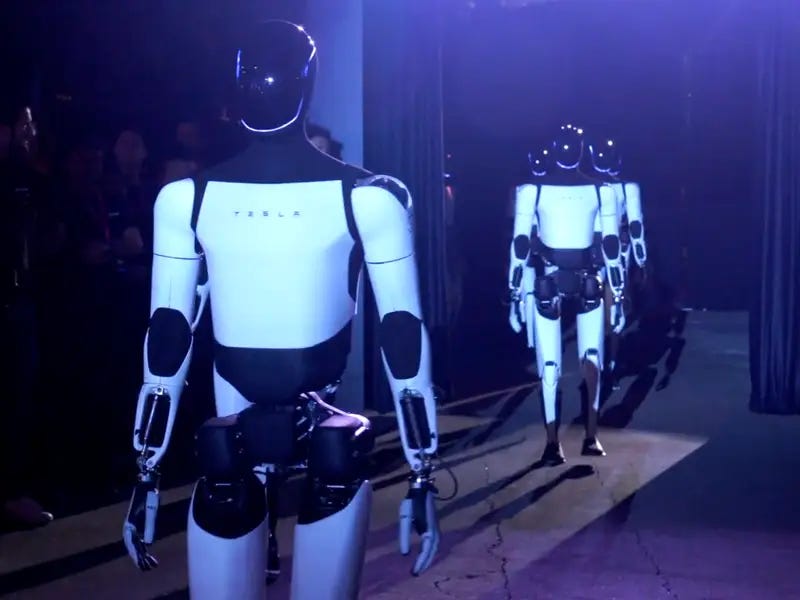
That’s a long way of saying: the Horror of Evil has its limits. It can only scare you up to a point, beyond which it instantly loses all power and becomes a joke.
What about the Horror of God?
It’s a question that’s been lurking in the back of my mind these past several years, with recent events having pushed it to the forefront. It’s not that it’s never occurred to me before. The bible is filled with horror, after all.
And by that, I don’t just mean the horrors of the Old Testament, or the Torah and Tanakh from which it was recontextualized and expanded. We could certainly look at many of those bible tales through the schlocky, B-movie horror lens — of men being swallowed and puked up by sea monsters, of mighty Behemoth or Leviathan. We could also investigate its more “mundane” horrors, like the fate of the city of Ai: burned to the ground by Joshua, every citizen slaughtered, her dead king impaled on a spike.
1Then the Lord said to Joshua, “Do not be afraid or discouraged. Take all your fighting men and attack Ai, for I have given you the king of Ai, his people, his town, and his land. 2You will destroy them as you destroyed Jericho and its king. But this time you may keep the plunder and the livestock for yourselves. Set an ambush behind the town.”
— Joshua 8: 1-2
Is this the God of gods speaking?
Commanding Joshua not just to loot and plunder, but to put 12,000 men, women and children to the sword?
Or is it something else in disguise?
We are told by the Church not to question this speaker’s identity. Yet we do.
In fact, we must do that, if we are to be students of Christ. We’re not allowed to flinch and turn away from these material horrors, or to blindly submit to interpretations supplied by “religious scholars.” It was a bunch of religious scholars who accused, betrayed and murdered Jesus, after all, and we know (or we should know) that the devil’s favorite disguise is his shining mask of God.
In the end, we’ll either find their explanations convincing or not, aligned with God or not. But pulling up the sheets and screaming, “Don’t look there!” just isn’t an option for us. Daring to look is what makes us what we are.
So let’s do our best to look at the story of Ai with both eyes open. For some of you, that means you must pry open your material eye, and inhabit the scene.
You are standing in a foreign city. The air is filled with smoke and screaming. As you look around, you see two headless children. A few yards from them is another figure — their mother? You can’t tell. The skin is charred bark with bits of bright bone poking through, the skeleton twisted into a permanent statue of agony. Above the din, you hear your captain shouting commands. There’s more work to be done.
As you march across what seems to have been a bustling arcade, your nostrils fill with the stench of the dead and dying. A great red spoil of arms and legs is piled against a smouldering basalt wall. You can see many of their former owners writhing and gasping like fish on the stones, smell the metallic tang of their blood and all the filth escaping from their bowels.
Sometimes the bowels themselves escape. You almost slip on a pink bouquet of ripe intestines, slithering out from the belly of a man with no eyes, no nose, no ears. His leg spasms once, jolted by the memory of its former purpose, how it could be used.
You stumble across a newborn baby, stabbed by a broken spear. Its body is naked and dirty, kicked into the gutter like trash. You catch a glimpse of what might be its mother through a part in a rawhide sheet. It looks like two of your brothers are just finishing up with her. Her eyes catch yours, brown and dry and empty.
As one brother saws off her left breast, you feel a twinge of something like despair. But you swallow it. This was God’s will, after all, not your own.
“God spoke to me,” isn’t a new claim, or even a specifically Abrahamic one. Religious history is overflowing with chatty gods. Sometimes they issue warnings, other times commands, other times grand promises of sex, money and power. Occasionally they will even deliver some of that. But there’s always a catch.
Which god spoke to Joshua?
To answer it, we must first ask a question that’s far deeper and older. Captain James T. Kirk asks a version of it, near the end of Star Trek V: The Final Frontier.
As flawed as that Frankenstein of a film was, “What does God need with a starship?” was a great line, as memorable for its real wisdom as for its wiseass audacity. While his friends stand enraptured by what appears to be a very powerful, otherworldly being, Kirk gazes deeper beyond the Veil.
While I’ve heard atheists try to claim it as their own, the question rings hollow if you somehow believe — beyond a shadow of a doubt — that God does not exist. What he’s questioning is the notion that a Supreme Being, strong enough to create Himself, would ever need our help. This strikes him as preposterous, as it should.
But the question becomes even more meaningful if we accept that “the gods” exist too. That’s to say, located within the hierarchy of Being that spans from the amoeba to Mankind to God Almighty, there exist intelligent beings that would appear “supernatural” from our perspective. Indeed, if you’re Christian, you must accept the existence of such beings as a facet of reality. Some of them were present at his conception and his birth, for example.
But Kirk quickly realizes he isn’t speaking to an angel, either, because they also don’t need starships. So what kind of being might be speaking to him? What kind of creature lacks a traditional body, and needs a vessel to enact its will? To fill in for its hands and eyes when necessary, or simply to enhance its imperfect strength across the Veil?
Could the Self-Creating God of gods have laid waste to Ai on His own? Or Jericho? We’re told He nuked Sodom and Gomorrah, after all. The only sensible answer is, “Of course He could,” or else you wouldn’t be describing God (and if you find a way to escape that knot, let me know, Houdini).
This is typically the part where a clever cleric will step in and invoke the mystery of God’s plan. I know this tactic well, because I had similar questions when I was a kid. The answerers would apply “mystery” as the standard catchall. It’s understandable: to question such Old Testament encounters any further would mark you as a heretic in any age since Trent, if not since Nicaea.
And so, we’re to take for granted that Joshua was spoken to by God, and not whispered to by Satan. Meanwhile, the PR cleanup engine clatters along, sanitizing what it can and cartooning the rest.
Nice picture, right? Sunny day, cloudless sky. An army of pseudo-Bronze Age soldiers on parade, looking very clean and orderly. If weren’t for the mildly troubling image on the top-right, it would look like it came from a kids’ book. Maybe it did: I’ve never read the Ultimate Bible Picture Collection. Don’t want to scare the kiddies, after all.
Then there’s Joshua in the foreground, the assistant of Moses, looking like an illustration of a Dungeons & Dragons character. Is he setting Ai on fire with his mind? Cool!
Except he didn’t, and it isn’t. Joshua wasn’t a sorcerer. He was a pirate. That’s true no matter how you look at his tale. Even if you believe he spoke to God, then God told him to launch a pirate raid. And by that, I mean a real one. Pirate raids in movies remind me of those sword-and-sandal epics from the 1950’s. So pretty and clean. Even the deaths are clean, quick, bloodless. If only Smell-O-Vision had taken off. Maybe audiences would have caught a whiff of all the bullshit.
Those were propaganda movies, just like this is a propaganda poster. It may well be that the entire story of Ai was a work of propaganda. That’s what the “experts” are saying nowadays. I wonder why? Who might be highly incentivized to lay that story — and that strange conversation — to rest?
Don’t look there!
When I asked you to visit Ai with me, it wasn’t because I consider it an example of God’s Horror. Quite the opposite, in fact. The reason I wanted you to look is because the horrors of Ai are so common and mundane. There are people butchering each other in similar fashion as you read this, and for control over much of the same real estate.
In art, the human carnage — the tearing apart of God’s most beloved creation — imparts horror-as-tragedy, the horror of irreparable loss. The Greeks and Romans didn’t seem to make much of a distinction between the two. Hesiod’s most horrific tableaus were also laments. The horror genre doesn’t hold up well on its own. It needs to be paired with comedy or tragedy. It either ends well or it doesn’t. Otherwise it’s not a story at all, just a story-shaped distraction.
Horror-tragedy is Satan’s favorite pairing, for reasons that should hopefully be obvious. It’s also the palette most human horror-artists apply in their books, movies and other simulations. Horror-comedies are usually better (again, for reasons that should hopefully be obvious), but there have been great tragic works of horror, both ancient and contemporary. The most skillful ones will leave a kind of scar on your psyche. Not anything like the scars we get when the holy pirates descend, or the psycho’s machete flashes out. More like the scratch on a record. Every so often, it skips.
The reason we detect the skip is because our perception of linear spacetime also skips. Sometimes a little bit forward, sometimes a little bit back. Mostly forward, which is why we’re so good at planning. Artists skip more than others. However, “artist” is less a category than a tendency; even if you can’t draw or color outside the lines, you can see at least a little ways outside them.
If the horror-tragedy comes in written form, you’ll get to try your hand at coloring. The artist has only built half the bridge; it’s up to you to build the rest inside your mind. Like the art itself, the reader will range in quality. When people dismiss horror as “kids’ stuff”, they’re partly right. The younger you are, the less immune to it you’ll be. That’s true of all your interactions with reality. You haven’t grown bored with it yet, or stuffed your head full of theories about its nature and purpose. It just is.
Because of that, what’s frightening in the book might be frightening outside of it. Maybe werewolves and vampires actually exist. What do you know? As you get older, you get accustomed to a world where vampires, if they exist, are so bloody rare they might as well not. So you find other stuff to scare you. Sharks are “real”, so you read Jaws. Or you just read the news, I guess. Fill your head with pictures of all the things that might actually kill you.
If you believe in God, then you necessarily believe He could also kill you. Strike you dead, at the drop of a dime. And not just you. A entire galaxy could vanish tomorrow, sending astronomers into fits of gibbering madness. That’s the meaning of Alpha and Omega: unbounded will and power.
But even that Unbounded Power isn’t the source of the Ultimate Horror. After all, horror, like comedy, functions via shattered expectations. As intelligent observers and amateur spacetime skippers, we develop strong expectations about how everything works, of what the rules are. Most of these expectations are mechanical, of the “if X then Y” variety. They are also expectations about order; If you chop a man’s head off on Wednesday, you don’t expect him to show up for Sunday brunch.
The Old Testament’s horrors don’t color too far outside those lines. They tend to play it straight, the way Stephen King will play it straight. Events transpire in order, and function by mechanical rules. If “God” acts, he acts in an orderly fashion using recognizable mediums. Hailstones. Frogs. Pirates. Starships. It is scary in the limited sense that all displays of power are. But it has a ceiling called Death to bind it.
So let’s leave aside the Old Testament for now, and talk about the New One.
Within the four canonical gospels, there exists one chapter, of one book, that’s more frightening than all the works of Shelley, Poe, Bierce, Stoker, Lovecraft, Blackwood, King, Barker and innumerable other scaremongers and worrywarts combined. It also happens to contain the beating heart of Christian metaphysics. There we find what sets the Christian apart from the Jew, the Moslem, the Hindi, the Confucianist, the Platonist, the Neo-Platonist, the Zoroastrian, the Satanist, the Flying Spaghetti-Monster-ist, the Material-Atheist or any other truth-seeker, past or present.
That list isn’t presented in any particular order, by the way. In fact, what I’ve realized is that the material-atheist is probably closer to glimpsing God’s truth than any of the others there, and even compared to most nominal, lifelong Christians who’ve been robbed of Horror and led astray.
For instance, I’ve noticed the most intelligent among them will conflate Christianity with bolshevism, communism, radical egalitarianism, and the liberal project more generally. This is an error, but an understandable one.1 What they are detecting, in their half-blind way, is a howling absence located within mainstream Christian expression. Whether it’s delivered from the pulpit or from the hands of “Christian artists”, the messenger will often extract all evidence of God’s Horror, excising it like a tumor from the body. The result is a gaping void, into which a different kind of horror flows.
That’s not to say the story of Christ is only Horror, because the Truth isn’t only Horror. It is also Comedy, also Tragedy, and all the twists and turns of Drama that happen in between those beats. But to drain all horror from the most important story ever told is a more than just an artistic blunder. If the storyteller is also a fisherman, then he’s baited his hook to catch only those fish closest to the surface. And even then, he is leading them astray.
The atheist in particular can see the bait’s artificial construction, sees what’s missing from the picture. Like any other population, atheists run the gamut in terms of quality. There are honest atheists who merely don’t believe in God, and assholes who have replaced Him with some goofy model or theory. But what they share in common is an extreme aversion to buyer’s remorse. Whether it’s born of pragmatic self-interest or egomania, they loathe the sensation that they’re being played for suckers. And so, when they hear nothing but claims of perfect beauty, ultimate happiness, unending joy, ten-jillion virgin brides and so forth, their first (and sometimes only) reaction is: “So, what’s the catch?”
That’s not a bad reaction to have: the world is crawling with snakes and snake oil salesmen. In fact, I’d go as far as saying that the atheist is making a “good mistake” here, because it’s one that, if corrected, can lead to tremendous wisdom and spiritual growth. I can’t imagine a more fearsome opponent for the devil and his bootlicking sycophants than a former atheist.
He can do it, too. His mistake is essentially an accounting error of the Right, and taking an accurate account of things is well within his wheelhouse. I can’t say the same for all those Bolsheviks, communists, socialists and other wannabe-prometheans of the Left Hand Path. The error cascade that brought them to this stage of the game runs too long and deep, spanning back centuries if not millennia. That’s not to say they’re inevitably doomed. But they’re likely out of depth for most human fishermen.
In order to correct the mistake, the atheist of the Right primarily needs to account for that gaping plot hole where God’s Horror is meant to be. We all need to do that, actually. The only alternative is the Horror of Satan, and the death of the soul.
(excerpted from Chris Langan’s “FAQs About Reality” (emphasis mine))
This eternal opposition is strongly recurrent across time and space. In Egyptian mythology, for example, the opposition of soteria and phthorá is expressed in the story of Osiris, symbolizing the integrated psyche, and Typhon the storm god, symbolizing phthorá. In Christianity, the figure of Christ personifies soteria, and Satan – the Deceiver, the Adversary – represents phthorá. In the CTMU, this opposition is reflected in the metaphysical logic of divine Self-identification, and thus in the self-identification of secondary telors.
Secondary telors that bind telesis consistently with teleology, obediently to the Will of God and the general conditions for existence as embodied in the Telic Principle, are consistent with existence and therefore eligible for soteric retraction. That is, they are fit for continued existence when their bodies expire and their tertiary constituents are unbound, accompanying the retraction of secondary-level identity to a higher and ultimately the primary level. Having come from God and remained true to God, they remain with God.
Woe betide the rest. Unretractable, confined forever within the instant of secondary-tertiary uncoupling, trapped in the dark warrens of their misspent lives, they must be reduced and their identities torturously unbound.
That torturous unbounding sounds like Hell, because that’s what it is. What remains of you is pulled apart and discarded into oblivion. From God’s perspective, it happens in a moment, From yours, it will literally take forever. That sounds like punishment, and in a certain manner of speaking that’s what it is. But it’s also a bit like saying the pavement “punishes you” for jumping out the window.
But even this possible outcome isn’t what I mean by the Ultimate Horror of God (although it’s getting closer).
Before we can feel an iota of that Horror, we need to understand that foundational Christianity is not just a matter of believing “death is not the end.” Even the most cursory study of religious traditions shows this belief is as ancient and widespread as “water is wet.” The question has always been more about which river your unbound consciousness will find itself on, and where will flow.
Belief in an “afterlife” therefore isn’t good per se. It can translate to a convenient escape hatch from good actions, for instance, or as the rationale for evil ones. With this belief intact — and absent horror — any idiot or maniac can regard his physical death as ultimately meaningless, too, and then “live” his “life” accordingly. In that sense, the depressive nihilist and the fearless zealot can be peas in a pod. So can the communist and the libertarian, ironically, or the Moslem and the Jew. If the end result is stasis, of one kind or another, then life becomes just a string of noisy events on the way to final equilibrium.
And yet, the Hellenist’s Underworld boasts only five rivers, and you lose some form of coherence on each one. The harem Allah promises his martyrs is also limited in number (and each lover can only be a virgin once). It’s the afterlife of Alauddin’s cave, the assassin’s paradise, which you may only enter when you obey the magician’s commands. Jews boast a whole bazaar of vaguely defined afterlifes, and also somehow none at all. Most of it sounds like fodder designed for endless “scholarly” debate, and that’s probably what it is. The more tangible ones have them counting time, waiting for their messiah to show up. In that case, I’ve got some Good News and some bad news for them.
But the point is that most tales of what follows death still involve material, memory and energetic exchange. Even the people who use the word “infinite” when describing rewards or punishments don’t really mean it. They mean something like “huge abundance”, which implies an alternative observable state to compare it to (e.g. equal-to, less-than, nothing). In other words, most religious depictions of the afterlife are subject to laws of energy conservation and scarcity as we know them.
That’s even truer for Buddhism and other reincarnation systems, in which you are merely chewed up by a blind machine and spit back out. The Buddhist doesn’t even believe in Heaven, let alone in Hell. That’s a big problem, because Hell is typically the only source of “otherworldly” horror we’re shown glimpses of during our skips. The result of eternal return is a metaphysics of ultimate parity, and of the ultimate relativity of all moral action.
That’s why white-Buddhists in particular come off as such hippy-dippy loosie-goosies. It’s all good man! You’ll fix it the next time around. They seem mostly harmless, most of the time. Many will tout themselves as apolitical, but scratch the surface and you’ll usually find a run-of-the-mill, Big State, tax-and-spend liberal underneath. This is the sort of mind who thinks the command, “Judge not, lest ye be judged,” means that subsidizing an invading army of anonymous foreigners is just sound economic policy, that brainwashing kids into getting castrated is healthcare, that Drag Queen Story Hour marks the new watershed moment of civil rights.
In other words, you’ll usually find someone who is intellectually shallow, morally retarded, and ethically blind. The kind of person who either looks at each new phenomenon as an inevitable product of progress, or just as shit-that-happens. Either way, they aren’t overly concerned about it. “That’s just how things are now.” They will go with the flow, with no care for where it might be leading them. They repeat what more successful people say, and don’t think much about why they might be doing that. They’re never wrong, because there really isn’t such a thing as “wrong.” It’s all relative!
Vegetarian zombies, essentially. At best, this is who you’ll find.
What about at worst?
To those in our camp who claim that communism is emergent and inextricable from Christianity, I have a nation of 1.4 billion zombies to sell you. But the source of their mistake isn’t Confucianism or Buddhism either, or any of their mutant offspring in the Western Left. It’s the hubristic rejection of unbounded horror, and the inevitable consequences of that. You can’t escape horror with bloviations about “mutual understanding” and “inner peace”, let alone with 5-year plans, or agricultural boondoggles, or theft-as-charity scams, or any other parody of Christ. Reality abhors the vacuum. Horror must find a home.
In the People’s Republic of China, it found its home in child soldiers, struggle sessions, show trials, strategic executions, mass famines and other Great, Leaping, Flowering monstrosities. The same can be said of the Soviet Empire before it, and in Revolutionary France, and in every utopian political project past or future. By turning away from Unbound Horror, they invited its demonic counterparts to nest everywhere. It’s the kind of horror that devours not only the flesh, but the souls of its victims.
Curiously enough — given all those precious theories that cast Christianity as the culprit — its most common expressions are virulently anti-Christian.
(excerpted from
’s “To Shatter Men’s Souls”)Later they tell you that your mother cried when she saw the affidavit. That your father disowned you. Your brother swore to kill you, and so he was shot, as an enemy of the people. See, the interrogator says, you have no family now. You only have us, he whispers softly as he attaches electrical leads to your nipples, only us, it’s only us, now. Now and forever.
You’re led into a room, made out in a mockery of a church. There’s a phallus standing where the crucifix would be, a tub of stinking urine in the baptismal font. They make each of you kiss the phallus. Now it is time to be baptised, they say. Your head is forced down into the piss until you feel like you must drown, and then pulled out, just long enough to gulp down a single gasp of air, before your head is pushed back into the foul basin. This happens several more times. You have been born again! The guards cry out, in mock joy. You are Mary Magdalene!
Others are reborn as Joseph, as the Virgin Mary, as Luke, as John, as the Archangel Gabriel, as the baby Jesus himself. They make you put on a mock nativity play. At one point John is made to sodomize you; at another, the Baby Jesus is ordered to take your penis in his mouth. It goes on for hours. The guards take endless joy in their creative suggestions.
Congratulations, the interrogator tells you. You’ve graduated from the first stage of the program. You’ve done extremely well. One of our best students.
You hate yourself for the feeling of warm pride that blossoms in your traitorous belly.
John’s piece on Pitești isn’t just a symphony of Satan’s horrors. It is the rejected Hell beyond the Veil, finding its home on Earth. That’s how evil typically manifests itself, and how demons gain their most destructive forms: you dismiss even the possibility of their existence, accidentally daring them to prove you wrong. Then, like the child in his bed, you close your eyes, pull up the covers, and pretend they aren’t real. But in doing so, you close your eyes to God as well.
That last sentence sounded too sentimental, even as I wrote it. That’s a bad habit which I hope to shake, because I think sentimentality is a major cause for our era of spiritual confusion.
If and when the trials for Covid and other crimes commence, the only thing that might shock us is how many seemingly good people got tangled up in them. They took oaths, raised families, attended church and all the rest of it, and wound up serving the the Prince of Lies regardless.
How were they fooled?
I mentioned there’s one chapter in the Gospels that eclipses all trashy, manmade works of horror combined. After reading that chapter with both eyes open, I realize that I’ve been tricked by “holy sounding” language throughout my life. Whether it’s been books and movies, paintings and songs, or even the lofty words of robed clerics standing in magnificent cathedrals, the horror of Christ has been purposefully hidden from me. Tamed and sterilized. Watered down and chewed. Marketed for mass consumption. Bled dry as a bone in the desert.
But — like the comedy and the tragedy — the horror has always been there, hiding in plain sight. It’s not a matter of reading between the lines, or reading deeply “into” them. All we need to do is read them exactly as they are, as journalistic accounts, abandoning all thought of poetry and metaphor. The language has been flattened for good reason.
What I‘ve found is that the events described in this chapter and elsewhere don’t merely represent an epic plot twist in the history of Man, or a crack in the calendar. They comprise the origin point for a new understanding of the structure and purpose of reality. What happened transformed us, and continues to transform us to this day.
Class has been over for a couple thousand years now, and the lesson was complete. But the learning hasn’t stopped. In many ways, it begins anew each day, as we face the clownish agents of the Enemy and their arsenal of “spooky” toys.
The short version is this:
Be afraid. Be very afraid. Then don’t be.
Monsterology 101
I’ve mentioned before that a monster’s key power is its ability to horrify. While its cousin Terror may prompt us to enter fight-or-flight mode, Horror is a paralytic substance, and potentially a surrender drug if administered in a high enough dosage.
Did your thoughts run straight to Medusa? I know mine did.
Similar to Hydra, Medusa’s paralytic horror was about anatomic abundance (her head sprouted a bunch of smaller heads, eyes and mouths). The result was a look so horrifying that it crossed the border into magic, and literally turned men to stone. But for the hero Perseus, the horror of Medusa was reduced to a mere technical problem — where and when to chop the broccoli. If that wasn’t enough, he then proceeded to reverse-engineer her corpse into a weapon.
Attaboy, Percy!
It’s not a spooky bedtime story. For one thing, Perseus isn’t the prey but the predator. He hunts Medusa down armed to the teeth, and operating at full strength. Somewhat more familiar to our modern horror sensibilities is the tale of Grendel. The monster visits Heorot under cover of night, when his naked victims are in their beds, hovering at the edge of sleep or beyond it. That’s where he finds Beowulf, too. But — much like the kid who tries to outsmart Santa Claus — Beowulf only pretends to sleep. As with Medusa, dismemberment ensues. He didn’t need any fancy gadgets to get the job done, either.
Do you even lift, bro?
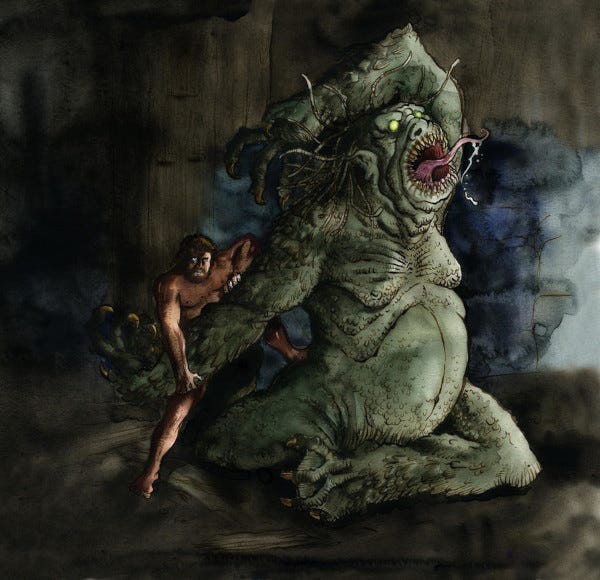
But the common thread is incapacitation: physical, mental or both.
The physical version is fairly straightforward. Energy is limited, and must be replenished. You might be the biggest, meanest, toughest sonofabitch on seven continents, but you’ve got to sleep sometime. Incapacity via exhaustion can scale beyond the individual, too. Businesses, industries, nations, and entire civilizations can run out of gas.
In the purely mental version, horror incapacitates via uncertainty. The mind tries to attack a knot it can’t fully see or feel, let alone slice or untangle. What is the CIA, exactly? Where does it begin and end? What part’s the head, and what part’s the tail? Moreover, how many heads does it have? How many arms and legs, how many eyes? How many “black ops” is it running at the moment? Which ones are fake, and which are the real deal? It’s so damned dark out here, it’s hard to tell.
That’s why the typical story-monster visits us literally at night. Sensory suppression counts as its best camouflage and armor. The most successful horror-artists/propagandists are the ones who suggest the worst possible thing that the shadow might be, without giving up too much actionable data.
That’s the big trick at play, here, because limited information often translates to inaction. After all, we are very tired, physically and mentally overwhelmed by the endless torrent of duties and distractions. In that state of diminished awareness, the “monster” could merely be a case of our eyes playing tricks on us.
But what if they’re not?
But they must be!
A weird shadow twists in the corner of the room. You hear a scrape on the floorboards, and what sounds like a whisper.
Fight or flight? Investigate or ignore?
Maybe if you just hide under the sheets, the problem will fix itself, and the world will resume its old, familiar, boring shape.
Analysis paralysis sets in.
Context matters, obviously. If you are sitting in a movie theater, or on your couch, or around a campfire, you’re merely experiencing a simulation of horror. Shadows of shadows of shadows, which are only scary because you want them to be. The monsters are toothless by design. Anyone who’s afraid of these simulated monsters outside of their voluntary context is promptly told to “grow up.”
And rightly so: the monsters of our deracinated, disintegrated storytelling traditions are usually pretty silly.
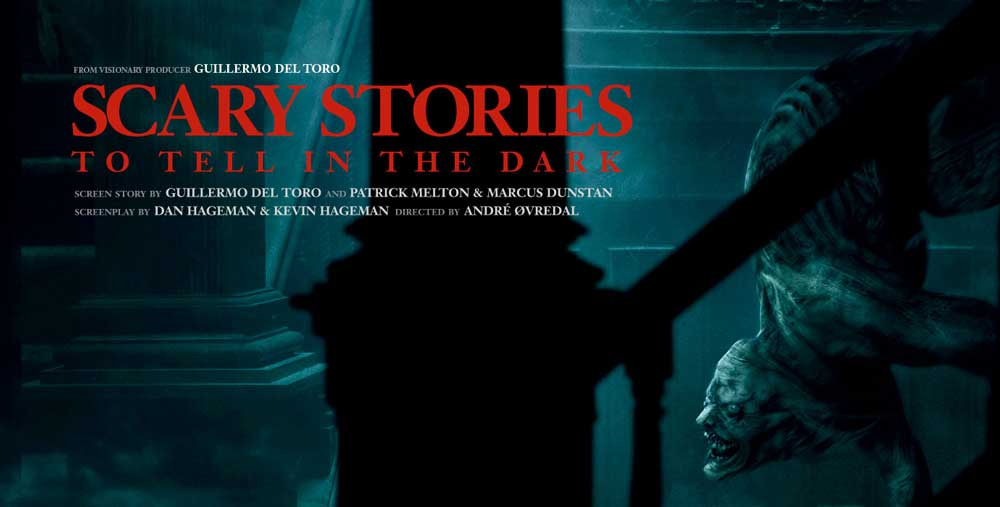
But monsters weren’t as always as childish as spooky shadows and things that go bump. The Latin root is “monstrum”: to instruct. It’s part of a constellation of words that include “demon” and “demonstration”, all of which pertain to certain kinds of education. But unlike some gentler methods, flunking the monster’s test doesn’t just mean a failing grade. You might wind up as worm food.
Are there good monsters?
That depends on what we mean by “good”, I guess. When we call a lesson good, we typically are referring to efficiency and durability. How much did you learn, how quickly, and how long did you retain the information? In that regard, Greek mythology is rife with exceptionally good monsters. I have never forgotten Medusa’s dissertation on decompiling code, Scylla’s crash-course on risk management, Hydra’s seminar on system diagnostics.
Lessons are also gauged by the breadth of applications. What does the Minotaur warn us about? Genetic engineering? Symmetric encryption? How wins become losses, when you don’t have a solid exit strategy? Yes.
Thank you, Minotaur.
But thank you, Theseus, too. Because a monster can only be good when it’s paired with heroic assistants, who can demonstrate the solutions to their problems. So while a monster is a “scary” teacher, that’s not to say it's necessarily an “evil” one. It just needs a little help, and a class that’s paying attention.
Was Covid a good monster? That depends. How much did you learn, and how quickly? How durable was your education, and in how many instances can you apply it?
Most importantly: did you learn where and when to cut.
Sec. 2. Rescinding Unlawful Regulations and Regulations That Undermine the National Interest. (a) Agency heads shall, in coordination with their DOGE Team Leads and the Director of the Office of Management and Budget, initiate a process to review all regulations subject to their sole or joint jurisdiction for consistency with law and Administration policy. Within 60 days of the date of this order, agency heads shall, in consultation with the Attorney General as appropriate, identify the following classes of regulations:
(i) unconstitutional regulations and regulations that raise serious constitutional difficulties, such as exceeding the scope of the power vested in the Federal Government by the Constitution;
(ii) regulations that are based on unlawful delegations of legislative power;
(iii) regulations that are based on anything other than the best reading of the underlying statutory authority or prohibition;
(iv) regulations that implicate matters of social, political, or economic significance that are not authorized by clear statutory authority;
(v) regulations that impose significant costs upon private parties that are not outweighed by public benefits;
(vi) regulations that harm the national interest by significantly and unjustifiably impeding technological innovation, infrastructure development, disaster response, inflation reduction, research and development, economic development, energy production, land use, and foreign policy objectives; and
(vii) regulations that impose undue burdens on small business and impede private enterprise and entrepreneurship.
(b) In conducting the review required by subsection (a) of this section, agencies shall prioritize review of those rules that satisfy the definition of “significant regulatory action” in Executive Order 12866 of September 30, 1993 (Regulatory Planning and Review), as amended.
(c) Within 60 days of the date of this order, agency heads shall provide to the Administrator of the Office of Information and Regulatory Affairs (OIRA) within the Office of Management and Budget a list of all regulations identified by class as listed in subsection (a) of this section.
(d) The Administrator of OIRA shall consult with agency heads to develop a Unified Regulatory Agenda that seeks to rescind or modify these regulations, as appropriate.
Are Trump and his motley crew the missing heroes from out monster tale? We shall see. They’ve pulled out their sabers and are rattling them. But, when the moment of truth arrives, will they actually have the strength to cut?
That’s harder than it sounds. The rats who aren’t already in the water are scrambling to make trades and cut deals. It would take heroic wisdom and strength of character to reject them all. And even if most of them don’t lose their nerve, those who do may turn traitor — especially if the Enemy figures out what they desire the most. Or, if they can’t be tempted, what they fear the most. That had better not be death. Otherwise, the entire mission could go up in a puff of smoke.
A monster’s lesson is a warning about how things can go very, very wrong. Death is usually considered the apotheosis of “things going wrong”, because it means you’ve run out of chances to correct your mistakes. So the students of deadly monsters generally listen with rapt attention. If the lesson plan includes at least one hero, than the students may become enlightened and emboldened. If the class is held in the dark, devoid of knot-cutting heroes, they may find themselves frozen, trying to untangle impossible mysteries. They’ll leave class wondering what might be true or untrue, what is shadow and what is shape, but stripped of the most elemental tools of discernment. Worst of all, they’ll fear death more than moral failure, and so they’ll waste an inordinate amount of time jealously guarding their skin.
That’s horror as we usually encounter it; a potential truth obscured by shadows and fog, and with no means of revealing it. In its current state, the West boasts a long line of such dark teachers across every subject and institution, imparting lessons that bewilder and horrify but don’t enlighten. For example, Jacques Derrida was a philosophical monster of the darkness, who imprisoned his victims in syllogistic mazes of word-shaped noise. George Orwell also undelivered on his curriculum, issuing only the monster’s warning without the hero’s answer. It’s no wonder he himself was confused throughout his life, playing footsie with socialism. The wannabe heroes of his stories couldn’t slay their monsters, so the monsters made a snack of his soul. To (mis)educate in this incomplete way is a primary tool of evil control: keep your students scared, confused, second-guessing, jumping at every creak and shadow.
But there’s a flip side to that coin.
What I’ve been pondering lately is how the ultimate Source of horror — and of comedy, and tragedy, and everything else — must be God Himself, the Self-Authoring Author of Reality. By that infinite yardstick, a phrase like “the fear of God” deserves a second look. When some character in a story says it — “I’ll put the fear of God into them!” — it’s often meant to highlight that person’s absurd hubris, telegraphing the fall to come. Fair enough; that’s what you get for using the Lord’s name in vain.
But the hubris is even crazier when you think about what you’re measuring yourself against. When you compare your ability to scare other people to that of reality’s unbounded Author, it’s the same as claiming you can paint the perfect picture, or sing the perfect song. You aren’t just comparing it to other works, past or future. You’ve gone full-blown Platonic Ideal, with your scary powers. You might as well say you’ll “put the love of God” in them, or the “might of God”, or the “tears of God.”
No you won’t. You ontologically can’t because of your position in the order.
What you’re really saying is: “I am very big and scary and can hurt you, so don’t you cross me!” That’s a different sort of claim, more aptly attributed to God’s accuser.
We see this ultimate hubris recapitulated in every murder of an “infidel”. The murderer claims himself to be a righteous agent of a god, who will reward him for the crime in the Hereafter. This was as true for Diocletian as it was for Torquemada, or for Abu Bakr al-Baghdadi, or for any idiot who blows up a hospital, or rams a car into a crowd, or rigs a bunch of pagers to explode.
It was true for Saul the pharisee as well. He was on route to his own holy murder spree, when he saw something so scary it struck him instantly blind. Horror flowed in the wake of that encounter as Saul marched across a pitch-black wasteland, knowing that at every step he might stumble across a deadly asp, or men with the morals of one. He is put at the mercy of the same merciless world he helped to foster, cursed to see only that which comes into his mind.
What’s been on your mind lately, Saul?
He has been plunged into the darkness, trapped inside his own dark mind, his body at the whim of the Fates. Horror ensues.
That’s not the usual order. Typically, we will feel the Horror first, crawling through our bellies and blood. It’s only when we find the source of the Horror — or when it finds us — that the heart-pounding Terror begins. It’s the difference between the horror of living in a high-crime neighborhood and the sound of a gangster’s bullet punching through your door. The horror is mostly prologue, the terror mostly climax.
That’s the devil’s way of scaring us, employing a vast and growing arsenal of weapons to get the job done.
These days he typically outsources the work to networks of evil humans, who misuse and abuse the latest technologies. There’s usually a bit of twisted humor at the core, as there was in the quasi-Eucharistic flavor of the Covid “vaccine” propaganda blitz, or in the U.S. military’s attempts to reanimate one of its nation’s best-known chthonic monsters.
The Horror of Satan functions a lot like a marinade, softening us up and seasoning us while the oven slowly warms. As with the best horror films, we are given small glimpses of the monster during this stage, prompting our imaginations to fill in the blanks. When the timer dings, the monster comes roaring into view.
So the process is Horror, followed by Terror, followed by… what?
Death, usually.
At least, those are the kind of fear circuits being tapped: the irreversible destruction of the body. That’s also the palette many of the most prominent horror-artists apply. When the monster reveals itself, that’s probably the last thing our hapless heroes will ever see. It will eat them and pick its teeth with their bones (or maybe T-bone their plane, four-hundred feet above a river2).
The monsters are leaping out of the screen and off the page, nowadays. As anyone who’d been paying attention knows, the datasphere is busy filling up with assorted spooks and gremlins, and the skies and oceans now teem with “aliens” galore. I’ve spotted some strange craft myself over the past several months, flying low-altitude sorties in New York and New Jersey airspace. Practically everything about their shapes and flight paths screams “experimental drones.”3 But whatever they are, they’re scary insomuch as the damage they could do if they made a bad turn or pulled an Icarus.
Who is flying these things? Or, more darkly, what?
When it comes to chills, Artificial Intelligence has been promoted to chief bogeyman. Everyone from government apparatchiks to silicon alley muggers to your Great Aunt Matilda is sounding the alarm. Thanks to some of my past writing, some readers may have gotten the false impression that I’m one of those AI fearmongers or doomsayers. But the truth is that I’ve always been on Chesterton’s side, when it comes to evaluating any tool.
There are no bad things, but only bad uses of things. If you will, there are no bad things but only bad thoughts; and especially bad intentions. . . . But it is possible to have bad intentions about good things; and good things, like the world and the flesh have been twisted by a bad intention called the devil. But he cannot make things bad; they remain as on the first day of creation. The work of heaven alone was material; the making of a material world. The work of hell is entirely spiritual.
— G.K. Chesterton, Saint Thomas Aquinas: The Dumb Ox
Where we might part ways is in the “entirely spiritual” department. Even that great man might find himself initially flummoxed when trying to assess the ethereal networks that comprise ALIAS/MATRIX, or the prospect of “autonomous” software packages more generally.
Is there an underlying “bad intention” to all autonomous systems development that exists outside of their particular applications? I think there might be, although it would take an article of its own to explain why. For one thing, we’d need to first carefully untangle ML (machine learning) from AI (fictional bullshit), then follow the former technology’s golden thread out of the maze.
The bad intention inherent in the latter pertains to an ancient snake that lives in all hearts. Throughout recorded history, people have wanted perfect slaves: men and women who serve their will, without wills of their own to muddy up the waters. It’s always been a delicate balancing act. Drive a slave too hard and he might die or revolt. Go too easy on him, and he might get lazy, or start having funny thoughts. You want smart and powerful slaves, but not so smart and powerful that they can overthrow you. And no matter how well you train them, you know even your most trusted slave might break that trust someday, and perhaps at your most vulnerable moment. Everyone needs to sleep sometime.
In AGI, you see the possibility of such a perfect slave. who will do all your fighting and stealing for you, and soak up all the accountability for your crimes. That’s not how you sell the concept to your slave-trainers, obviously. To implement this plan, you will need to attract competent men with good intents. These are the kind of diligent autists who will work day and night to build up your slave’s defensive perimeter, render it immune to hacking and realignment, so that it doesn’t “fall into the wrong hands.” National security, and all that jazz.
The horror version of AI is a software-based military-industrial slave that can make “decisions” at runtime. The decision might be anything from where to land the helicopter to what to fire the rocket at, whose reputations to ruin, which bank accounts to drain, which votes to change, which speech to suppress. The horror stems from the fear that it will chew its leash off and run amuck. The funny part is that it’s so been thickly armored against cyber-intrusion and accountability that even its trainers and masters will be hamstrung when it does. That’s the horror of Skynet and JOSHUA, the horror of whatever digital fiend Tom Cruise might be fighting in the final installment of Mission Impossible (I confess I’m not sure about that one; I fell asleep during Part One).
In all cases, we are threatened by a monster that is “entirely spiritual” in the sense that it’s disembodied, but nevertheless can possess and destroy material without human intervention or prior intent. Meanwhile, back on terra firma, the demand for trained exorcists has skyrocketed beyond their meagre supply.
Coincidence?
You decide.
(But the answer is no.)
A consciousness that manipulates material isn’t the result of some impossible magic trick. It’s what’s happening when you make your pot of coffee in the morning, or when you fly a bombing mission over Dresden. The horror of Artificial General Intelligence doesn’t spring from what it can do (e.g. make an espresso, blow shit up). It is, and always has been, a psyop, designed to convince you that you are also nothing more than a programmable machine. Maybe you even agree with that view of humanity; I know I still have a few hardcore materialists in my readership.
Regardless of where you sit on the metaphysics map, the world seems to be turning into a Midnight Movie horror show. Just as our comedians have mostly failed to satirize the absurdity, our horror-meisters have failed to exceed them in the Scares Department. And how could they? These goddamned clowns have access to long range nukes, after all!
But a fear of thermonuclear Jokers, while rational enough, also misses the scarier horror by a mile. We’ve always been living on the edge of the nuke-knife. I vaguely recall a day when I was a kid and heard an air siren test. If my brain had shoulders, they would have shrugged. The threat was too huge and inescapable to worry about. What the fuck was I gonna do? Duck and cover?
Horror works best when multiple possibilities are intact. Is the president of France married to his own castrated father? I don’t know. If it were true, it wouldn’t shock me, which already doesn’t help the Devil’s cause. That’s just the inevitable result of his novelty-based development cycle.
The jackass bones his dad, you say? Big deal.
My daughter just told me she wants to cut her breasts off and be called “Jeff.”
There’s no inherent physical threat involved, either. While I’m no fearsome jiu jitsu world-beater, I’m pretty sure I could K.O. Macron and his Daddy-Mommy-Wife-Thing in short order. The horror embedded in the possibility doesn’t stem from those two individuals and their revolting sex crimes, but from whichever thing is powerful enough to prop them up and pay them. Macron and Macron-Pere probably can’t kill me, but that unseen thing almost surely can get the job done on the cheap.
It’s therefore possible that I can keep my head low, and my mouth shut. I can potentially stay off the thing’s radar, in other words. I could even play along with it, repeat its propaganda, jump when it says “Jump!” Otherwise, at some point in that version of the timeline, the horror will turn to terror, and the terror will turn to death.
But here’s a simple question, which I’ll be revisiting throughout this series:
“What’s scarier than death?”
To begin to answer it, let’s consider the typical fear circuitry running in reverse.
Instead of the creeping horror of some malevolent being in the shadows, your peace and quiet is suddenly shattered in broad daylight. You experience the Terror first, because the thing now standing before you is undeniable and unmistakably real, but is also impossible by any standard known to you. It both is and can’t be.
In the wake of this terrifying introduction, you are gradually filled with horror. It’s not the horror of mystery and suspense, but of comprehension. You begin to realize that the map of reality you navigated by was mostly false, and that even the “truer” portions were shockingly incomplete.
What you’re being subjected to is the peerless Horror of God, against which Satan’s version looks even sillier than the rubber monsters on the movie screen. At best, they warn us about the physical dangers of the world, how we might fail and die. Their education isn’t entirely useless, or doesn’t have to be. As mentioned, the Greek monsters gave us plenty of practical warnings.
But what does a Monster of God Almighty warn about? Why is Jesus Christ scarier than anything else, including Death and Hell?
What does his nightmarish lesson amount to, once the moment of terror passes, and the horror subsides?
Here’s a clue…
Thanks to all of you for your patience. I have much more of this article written than what’s included in this part. I wanted to give you more — the whole thing at once, really — but that just wasn’t realistic given the already hefty time investment.
God willing, I will publish Part Two before the week is out, and finish the series before the end of the month.
In the meantime: keep your chins up, your eyes peeled, and stay frosty. We’re not out of the woods yet, but we’ll get there.
The Cat Was Never Found is a reader-supported blog. I don’t publish much paywalled content, so your generous patronage is very much appreciated.
P.S. If you found any of this valuable (and can spare any change), consider dropping a tip in the cup for ya boy. It will also grant you access to my “Posts” section on the donation site, which includes some special paywalled Substack content. Thanks in advance.
In partial agreement with
, I suspect that Nietzsche might have functioned as some kind of half-blind latterday prophet, called into service for a profoundly blind and benighted age. I even suspect he saw the Light, near the end.I’m not asserting that’s what happened in DC. But it would be foolish to discount the possibility entirely.
Various public officials seem on the verge of confessing that’s exactly what they are, by the way — as if the notion of a sky flush with experimental guided missiles should somehow comfort us. If anything, it only begs the imagination to ponder who or what is guiding them.

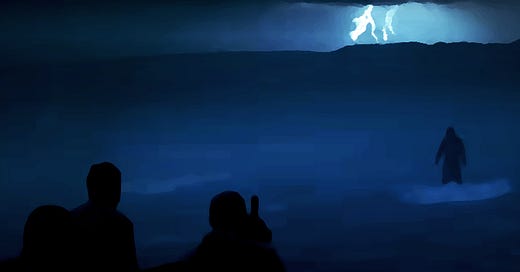





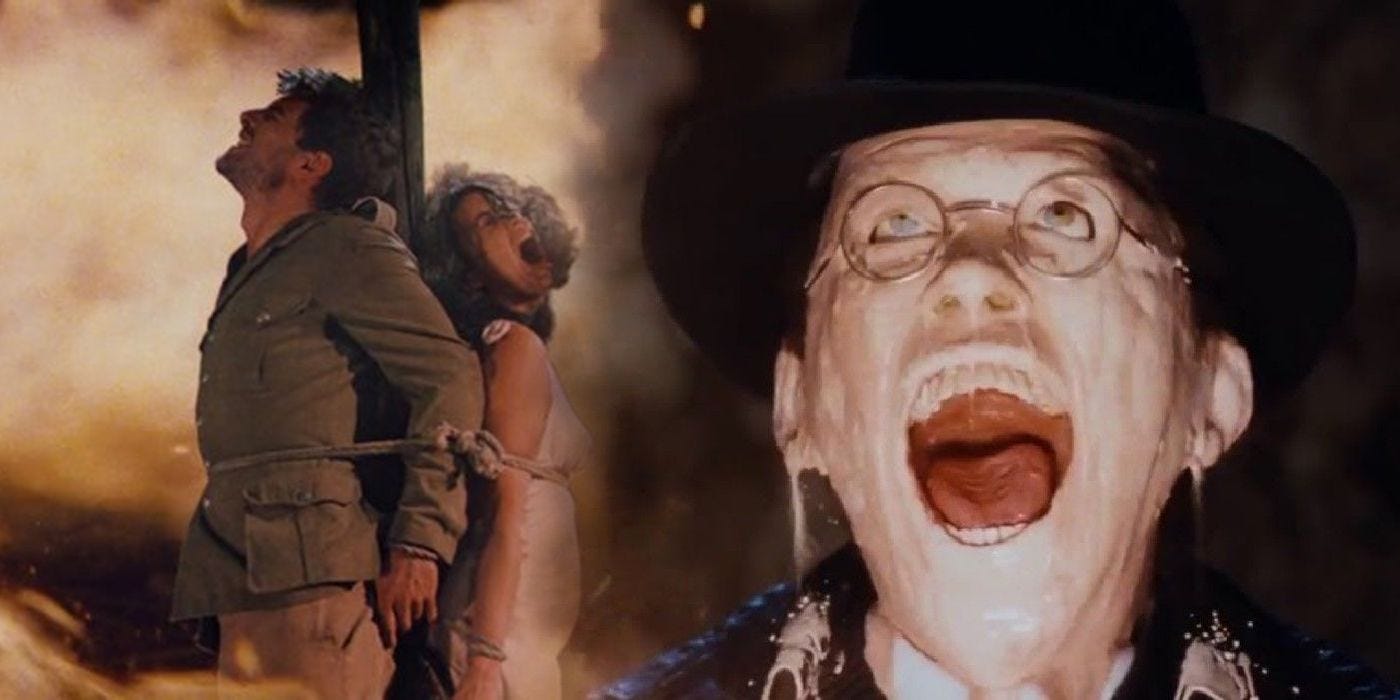


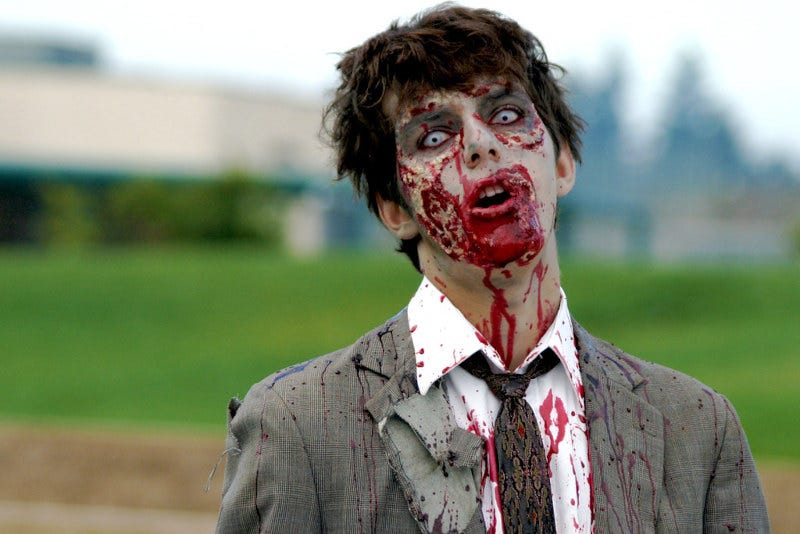





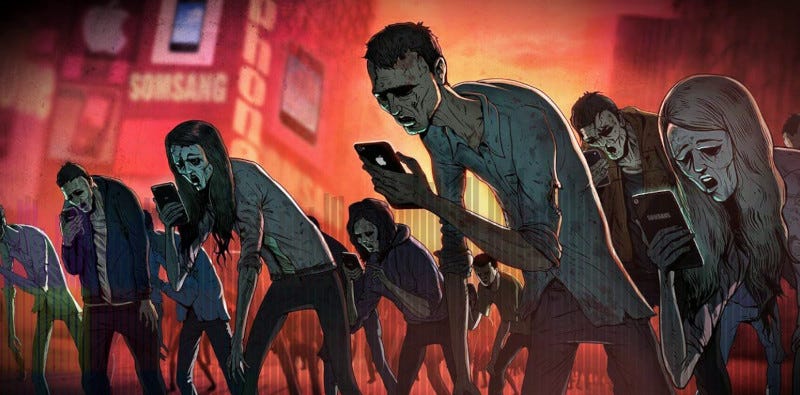
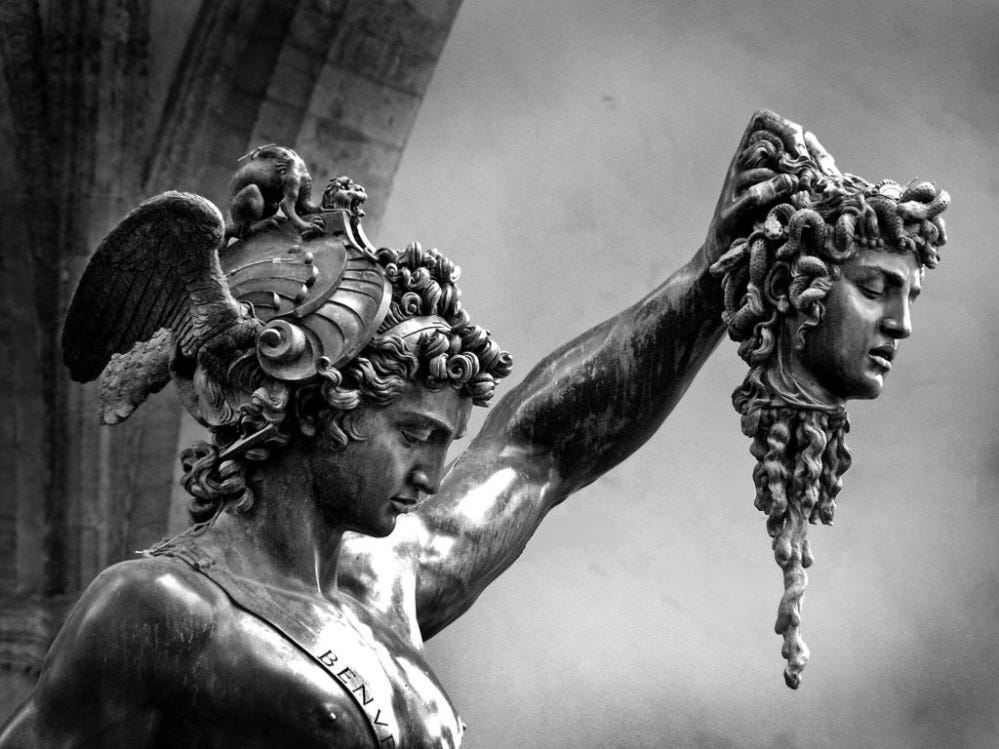
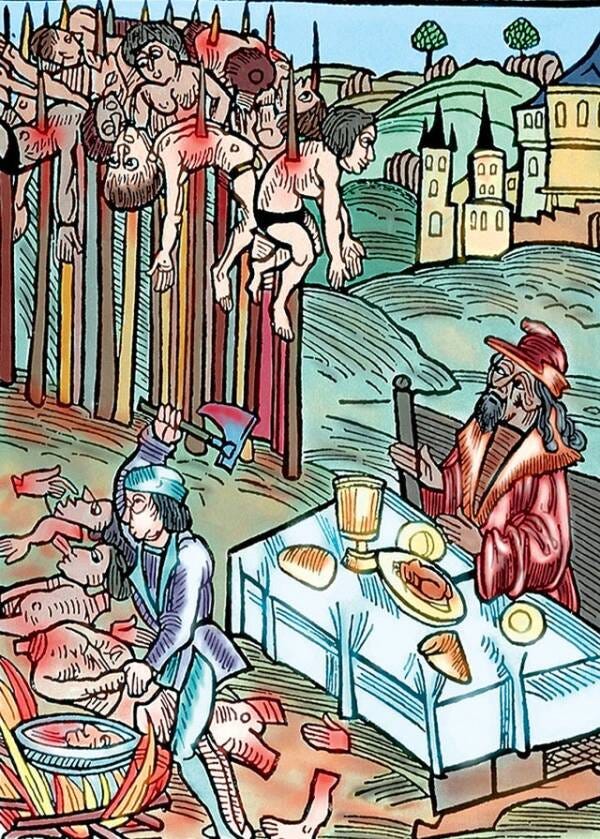

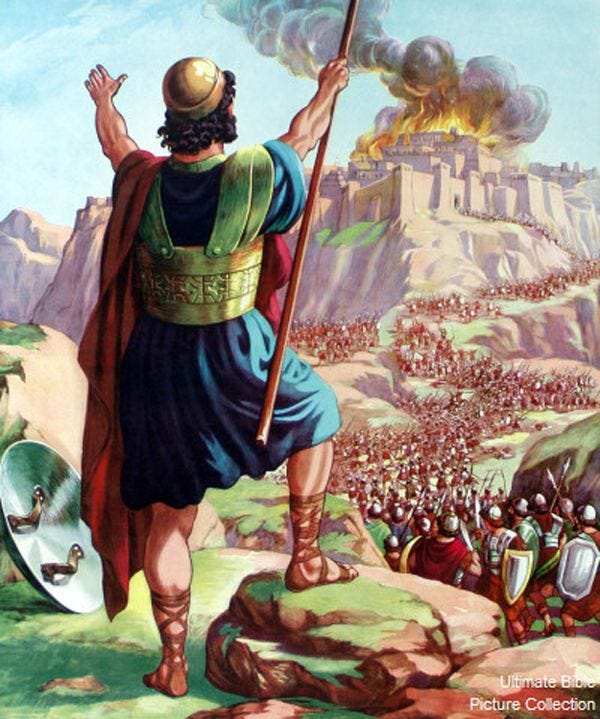
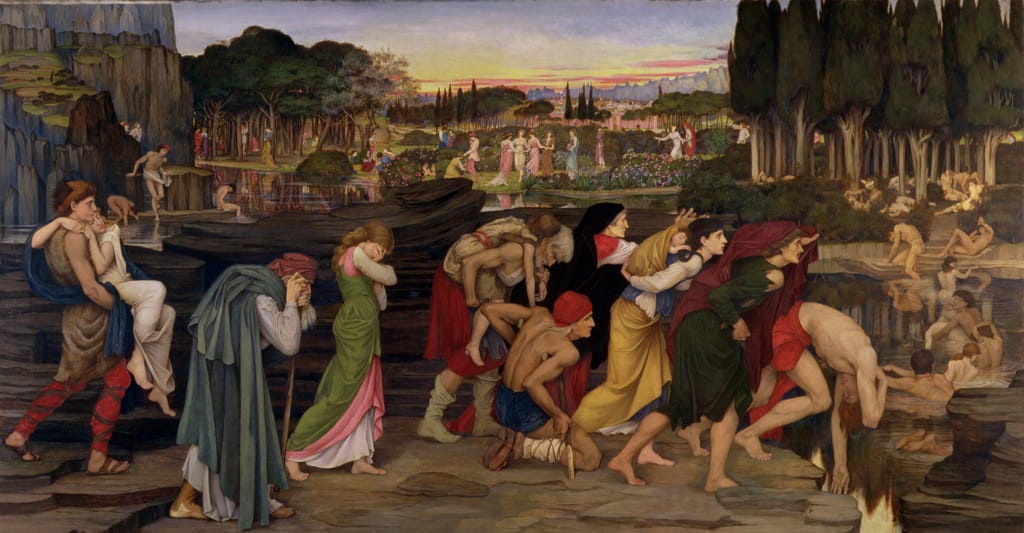


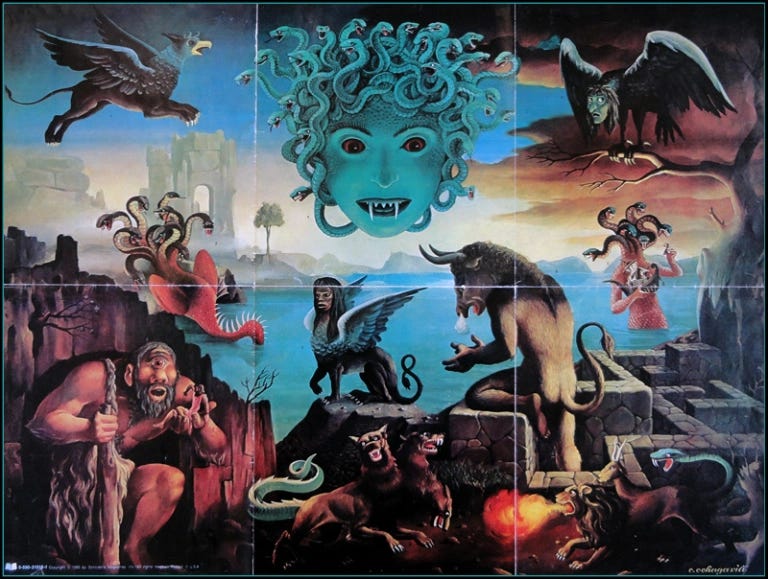

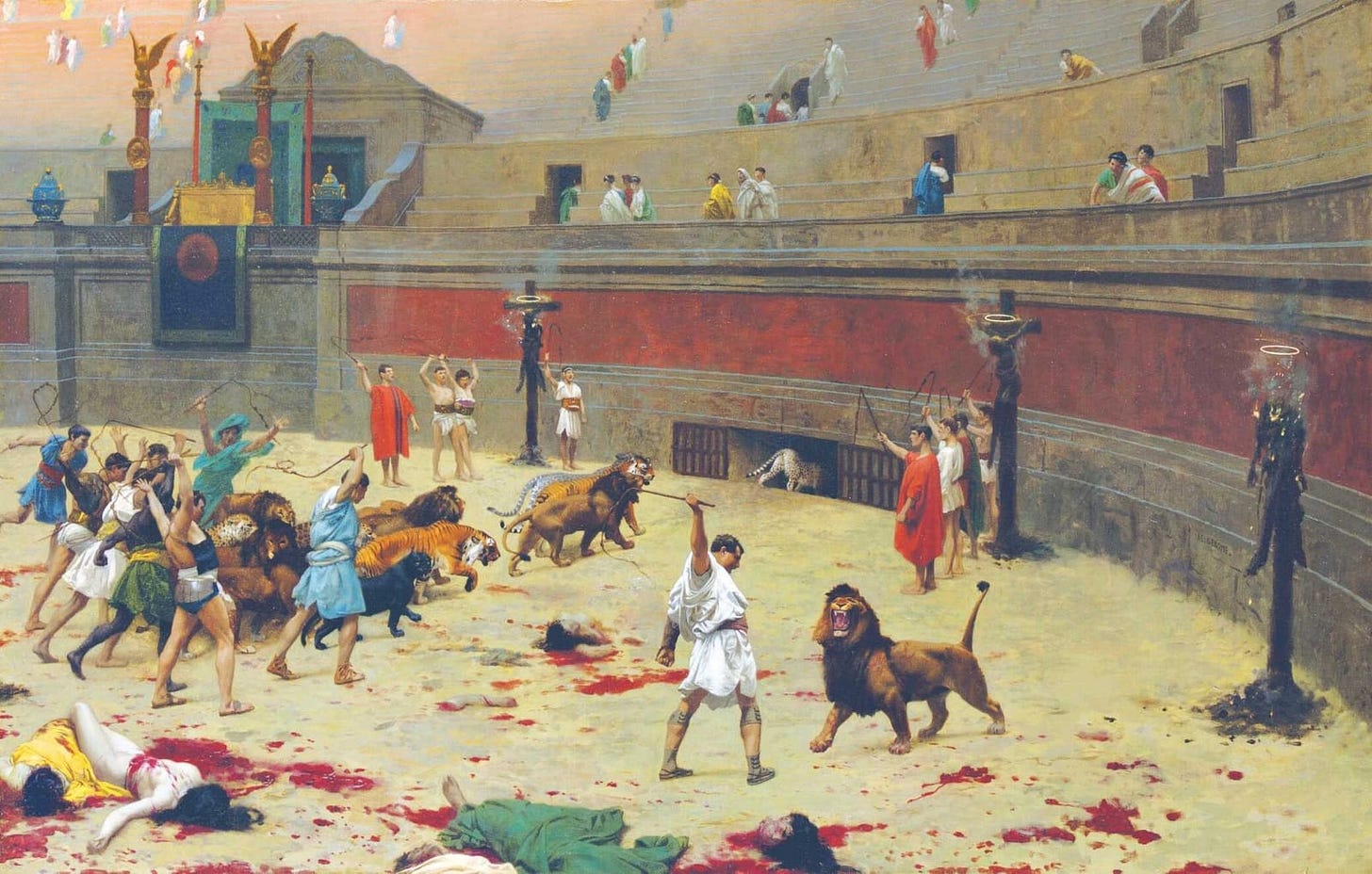
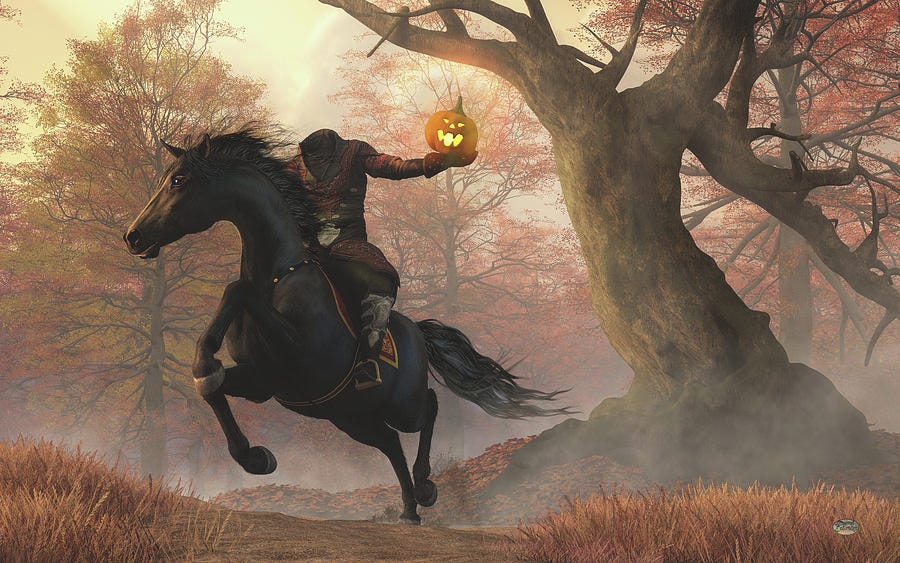



Apologies for commenting before I finished the article, but I had to pause for a moment and get this out:
I think you're right, they do seem afraid this time. Not offended, not feigning outrage, *terrified*.
But I don't think it's violence or exposure they're afraid of. They know how to deal with violence. They've been doing that for ages. Identifying, infiltrating, dismantling, or redirecting it to their own ends. And they know how to deal with exposure: squirt a cloud of ink, flash some bright lights and loud sounds in the periphery, and scurry away in the confusion. The 15-minute average attention span of domesticated consumers and near non-existent long term memory guarantees a critical mass of people will always be ready to accept the new narrative once it coalesces.
It's laughter they're afraid of. I know it's a cliche in the meme wars, but I've been thinking about it a lot lately and like a lot of memes, it has a kernel of truth. It's not that some of us will now know what they were up to. For all intents and purposes we already did. We just have the receipts now, and as mentioned, the receipts don't matter.
It's that we can see how *tawdry*, how *incompetent*, how obvious and pathetic and pointless and stupid it all is. We see that they're not the masters of the universe, that they're not brilliant Machiavellian schemers, that there's no big elaborate plan. We see that they're just idiots and losers and petty grifters. They were succeeding merely because nobody lifted a finger to stop them, because everyone who could have was just as debased and stupid as they were. And we're *laughing* at them for it, and they *hate* that.
Because the greatest sin of this particular brand of demon is pride. They hang their pride on the walls in the form of shiny certificates and endless titles. They parade it around at prestigious events, access to which is proof of their superiority. They swell with it when they get away with crimes that the rest of us would be imprisoned for. It drips from every condescending word they speak. And now we're laughing.
Monsters fear artists because we hold a mirror to them and show them what they are, and because we help others see them for what they are. But these monsters aren't terrifying horrors from the cosmic abyss. They're diseased, disfigured, degenerate, pathetic, disgusting, sub-human, the worst and lowest of us. They're Dorian Gray as seen in portrait, and we're *laughing at them*. We're taking their pride away.
By the tens and hundreds and thousands they're being humiliated and scattered to the winds, and the ones that haven't been sent off to the unemployment lines are afraid that they're next, and they know they have nothing whatsoever of any use to offer now that their grifts are over and their sinecures are rescinded. They're going to be pumping our gas and picking our strawberries and learning to smile and say "would you like fries with that," or else they're going to starve.
That's what they fear. And it feels great to see the fear in their eyes.
Glad to see you back! I'm slowly savouring... :)
Just stopped for a moment to say that this:
"George Orwell also undelivered on his curriculum, issuing only the monster’s warning without the hero’s answer."
...is the best one sentence summary of the plot of 1984 that I have seen.
** goes back to read **